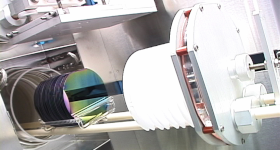Epitaxial Silicon
Cold-wall reactors are conventionally used for epitaxial silicon growth. However, the cold-wall process is expensive as the number of wafers that can be processed per batch is severely limited. Studies of the past quarter century have demonstrated that, with modest modifications, LPCVD tubes can be used for epitaxial silicon deposition and active device regions can be doped in situ during epitaxy.
In general , lower pressures allow lower temperatures to be used. A turbomolecular pump is used for removal of traces of oxygen and water prior to deposition and is interlocked to prevent reactive gases from flowing through it. The requirement to be both vacuum-tight and tolerant of high temperatures can be met specially designed water-cooled flanges on both ends of the process tube.
Epitaxial silicon is grown at 850-1150°C and pressures between 50 Torr and atmospheric. In general , lower pressures allow lower temperatures to be used. A turbomolecular pump is included for removal of traces of oxygen and water prior to deposition and is interlocked to prevent reactive gases from flowing through it. The requirement to be both vacuum-tight and able to tolerate these high temperatures requires water-cooled flanges on both ends of the process tube.
- Typical Film Thickness: 20 nm - 1.0 µm
- Batch Size: > 25 (18" flat zone) or > 50 (34" flat zone)
- Deposition Rate: 3 - 15nm/min. (30 - 150 Å/min.)
- Deposition Gases: Dichlorosilane (SiH2Cl2)
- Deposition Temperature: 830 - 950 °C
- Deposition Pressure 50 Torr to Atmospheric
Applications: Modern day microelectronic devices, solar cell emitters
LPCVD Processes
- Silicon Carbide Devices
- Silicon Nitride Resonators
- Doped Silicon by LPCVD
- POLYSILICON LPCVD WITH SILANE (SiH4)
- POLYSILICON LPCVD WITH DISILANE (Si2H6)
- LTO, DOPED LTO, BPSG, BSG, AND PSG LPCVD
- HTO LPCVD
- TEOS LPCVD
- Silicon Nitride LPCVD
- Low-Stress Silicon Nitride LPCVD
- Stochiometric Silicon Nitride LPCVD
- Silicon Oxynitride (SiNxOy) LPCVD
- Silicon Germanium (Si-Ge) LPCVD
- SIPOS (Semi-Insulating Polycrystalline Silicon)
- Polycrystalline Silicon Carbide
- Epitaxial Silicon
- Nano Materials LPCVD



